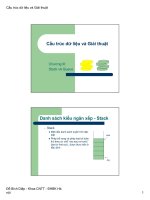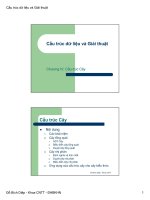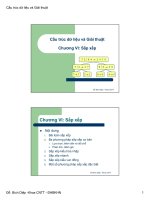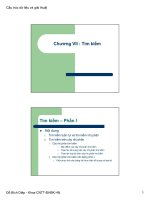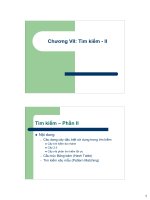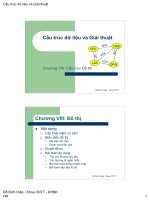Bài giảng cấu trúc dữ liệu và giải thuật 15
Bạn đang xem bản rút gọn của tài liệu. Xem và tải ngay bản đầy đủ của tài liệu tại đây (4.07 MB, 243 trang )
Foundations in Data Structure and
Algorithms
Truong Tuan Anh
CSE-HCMUT
Outline
Basic concepts
z Revision
z
2
What is Data?
3
What is Data?
z
Data
z
z
Example
z
z
z
Data is information that has been translated into a form that is
more convenient to calculate and analyze.
Numbers, words, measurements, observations or descriptions
of things.
Qualitative data: descriptive information
Quantitative data: numerical information (numbers).
z
z
Discrete data: can only take certain values (like whole numbers)
Continuous data: can take any value (within a range)
4
Data Type
z
Class of data objects that have
the same properties.
Define a data type
1. A set of values
2. A set of operations on values
z
Example
5
Data Structure
z
What is a data structure?
1. A combination of elements in which each is either a
data type or another data structure
2. A set of associations or relationships (structure)
that holds the data together
z
Example
z
An array is a number of elements of the same type
in a specific order.
6
Abstract Data Type
z
Aim
z
z
z
Users know what a data type can do.
How it is done is hidden.
Definition
An abstract data type is a data declaration packaged
together with the operations that are meaningful for the
data type.
1. Declaration of data
2. Declaration of operations
3. Encapsulation of data and operations
7
Abstract Data Type
8
Example: List
z Interface
Data: sequence of elements of a particular data
type
z Operations: accessing, insertion, deletion
z
z Implementation
z
z
Array
Linked list
9
Algorithm
What is an algorithm?
The logical steps to solve a problem
What is a program?
Program = Data structures + Algorithms
(Niklaus Wirth)
10
Pseudocode
z
z
The most common tool to define algorithms
English-like representation of the algorithm logic
Pseudocode = English + code
z
z
English: relaxed syntax being easy to read
Code: instructions using basic control structures
(sequential, conditional, iterative)
11
Pseudocode
z
Pseudocode
z
z
z
Algorithm Header
Algorithm Body
Algorithm Header
z
z
z
z
z
z
Name
Parameters and their types
Purpose: what the algorithm does
Precondition: precursor requirements for the parameters
Postcondition: taken action and status of the parameters
Return condition: returned value
12
Pseudocode
z
Pseudocode
z
z
z
Algorithm Header
Algorithm Body
Algorithm Body
z
z
z
z
z
Statements
Statement numbers: decimal notation to express levels
Variables: important data
Algorithm analysis: comments to explain salient points
Statement constructs: sequence, selection, iteration
13
Pseudocode: Example
14
Data Structures
15
Data Structures
16
Data Structures
A member of an object can be accessed directly by a dot (.)
inserted between the object name and the member name
17
Data Structures
18
Data Structures
19
Exercise
z
Define a data structure student_t containing
a student's name, first name, and age.
z
Write a code in C++ to take input your data
and display it.
20
21
Class
22
Class: Example
23




